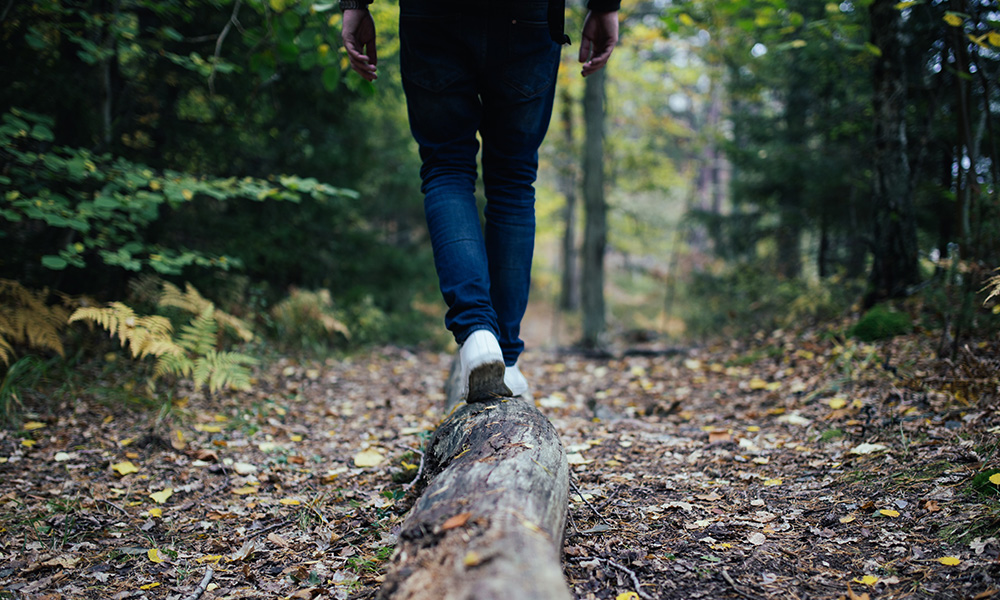
Practice mindful walking in your local park or forest. Photo by Biel Morro on Unsplash
Mindful walking is a way of learning to enjoy the simplicity of the present moment. It’s not a weird, uptight way of walking. It’s all about being natural and relaxed, but paying attention in a particular way.
Berlin based dynamic movement and mindfulness teacher Tatjana Mesar often includes mindful walking exercises in her yoga classes and teacher training courses. She says it teaches people to maintain a broader awareness of what’s happening in the moment, rather than being distracted by one thing or another.
“Walking mindfully is an opportunity to make life fresh everyday,” Tatjana says. “Even though we walk the same route, with a mindful mindset it will be fresh each time.”
Let’s be honest, it’s easy to get distracted while taking a stroll, especially in the city. Attention grabbing advertising, attractive people who catch the eye, and loud noises – they bombard our senses, tugginh them in different directions.
“We do live in an attention economy so there are a lot of things designed to rob our attention,” Tatjana says. “Mindfulness helps us remain aware of the whole picture rather than being pulled into those things.”
All this sensory stimuli can be pleasant or unpleasant, Tatjana expains, causing us to either be attracted or repelled. Police sirens might cause us to tense up, and feel the urge to move away. Colourful lights, on the other hand, catch our eyes and draw us towards them. This constant pushing and pulling is tiring. We can also get lost in our own thoughts, becoming oblivious to the world around us.
Here are Tatjana’s five steps to learn how to walk mindfully.

Mindful walking helps us to feel and notice more as we walk. Photo by Jon Flobrant on Unsplash
Take mindful nature walks
It might be a lot easier for you to learn to walk mindfully in a nice park or forest than in a busy city. There are far fewer distractions and it’s easier to relax, which is the heart and soul of walking with presence. “When we remove ourselves from the city and go into nature, our senses become more open and curious and we immerse ourselves in the landscape,” Tatjana says. “Now the trick is to apply what we learn to the city.”
Open your awareness
Whether you’re practicing mindful walking in nature or the city, the next step is to learn to maintain a wide field of awareness rather than being pulled into details. There are two aspects to this:
Sight: “Allow everything to enter your visual field without picking and choosing one object,” Tatjana says. “When you notice you are caught in a detail, simply widen your perspective again. It's like a camera; we can choose wide or narrow lens. We want to maintain a wide angle perspective.”
Sound: This is the same as above, but applied to what we hear. Rather than zooming in on one sound, try to maintain a broader awareness of all the sounds around you. This takes time and practice to learn. “Try to keep the attention present on everything you are hearing,” Tatjana says.
One footstep at a time
The next step is to learn to anchor your attention on the process of walking itself. The main anchor point is the feeling of the feet on the ground. There are two stages to this:
Each step: To begin with, just focus on the feeling of your feet on the ground; the weight shifting from one foot to the other. “ If your mind is very busy, you can stay with this the whole time,” Tatjana says. “Just know when your feet are touching the ground and the movement of the body. Don’t interpret it in any way, just stay with direct recognition.”
Whole body: The second stage is to broaden your awareness to include feeling the whole body, as well as your feet. Notice the legs and arms swinging, and the subtle rotation in the spine. “Be aware of movement unfolding in the body as you walk,” Tatjana says. “As the body moves the mind rests in that movement rather than running away with thoughts. I compare it to lying in a hammock; the hammock is moving, but you are relaxed.”
Keep it fresh
Humans are creatures of habit. We like to have a comfortable routine to stick to. But this can cause us to operate on automatic pilot, so we don’t really tune into what’s happening. “If we make our walking a routine, doing the same thing everyday, then we end up on autopilot, limiting life to mindless repetition,” Tatjana says. “It’s important to realise that we have other options. So don’t always walk in the same streets. Find a way to change the route.”
Practice at home
Mindfulness is all about interrupting our routines so we wake up to the freshness of life. Home is usually a place we are the most routinised. “It’s nice to slow down at home and be aware of your feet on the ground as you walk around,” Tatjana says. “Learning to slow down is the key.”
Lead images:
Photo by Jon Flobrant on Unsplash
Read more articles
How to walk your way to good health